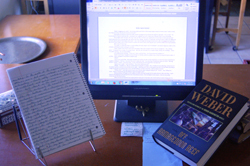Different Brains, One Writer
Over the last several weeks, I’ve been working on two projects side by side. One is typing up the mysterious “handwritten project.” That’s the project I started last October, when I had been doing so much editing, proofing, non-fiction, and the like that I felt I’d lost touch with my fiction-writing self.

Splitting the Jobs — and the Brain
So, rather like a certain swashbuckler in The Princess Bride, I decided to go back to the beginning. For me, that was going back to writing by hand, rather than on a computer. It meant writing without thinking about whether what I was doing was publishable or not, whether what I was writing was a short story or novelette or novella or novel, whether it made much sense at all. Just writing.
I wrote like this from mid-October to mid-January, filling three notebooks of assorted sizes and shapes, and running pens of multiple colors dry. In February, I started typing it up, mostly because I wanted Jim, at least, to be able to read it, and deciphering my handwriting would get in the way of the story.
This “typing” is more than just transcribing, since I’ve sometimes found a need to flesh out a segment, adding description or detail as needed. In a sense, it’s a first edit of the piece. That means in order to do it I’ve had to switch from what I think of as my “writer brain” to my “editorial brain.”
That’s fine. I do this all the time, with every project. But this time something different came up…
Because all I was doing was “typing,” and I still craved the pleasure of writing a story, I decided to get started on a piece I’d promised David Weber for a forthcoming anthology set in his “Safehold” universe. I spent some time reviewing the setting, decided I didn’t want to write the story I’d initially planned, and came up with another.
Aside: As I’ve mention before, I’m an intuitive plotter, pretty much a “10” on a scale of one to ten. This means that writing proposals can be dangerous for me because, once I know how a story is supposed to end, I tend to feel it’s done and not want to write it anymore. That’s what happened here.
Once I had my new idea, I was pretty pleased with it, so I was surprised to find that the initial writing was going more slowly than I’d anticipated. After a while, I realized that because I was starting each day with an hour or so of typing up of my handwritten draft, I had basically put my brain into editorial mode, rather than writing mode. This tendency to stay in editorial mode was enhanced by my sense of responsibility to Weber’s setting, because I kept doing editorial things like looking up names of things or checking dates.
Eventually, I had to put my copy of Off Armageddon Reef to one side, resist the desire to consult the glossaries and notes Weber had sent contributors, and just go ahead and write the story, trusting that I could add those details when the story was done in rough.
As soon as I did this, my writing brain was set loose. I became completely engaged with the story: living and breathing my characters, experiencing the situation I’d put them in not with my brain alone, but with my emotions. I finished a rough draft of the story on Friday, and, as you read this, am awaiting Jim’s response. The story should be off to Weber before the end of the week.
My personal adventure with having to harmonize the sides of my brain so that I could work on these two projects at once started me thinking again about how writers are frequently divided into two categories: outliners and intuitive writers If you aren’t familiar with these classifications, I talked about them a few months ago here.
Now I’m wondering if the difference between these types of writing has to do with how much of the editing side of the brain the writer engages while creating.
In my case, possibly because I had to learn how to turn off all the literary critical stuff I learned when working on my various degrees in Lit, I don’t write well when my editorial brain is engaged. In contrast, I’ve noticed that outliners tend to have a part of their analytical brain engaged at all times. They’ll happily tell you how this sub-plot will play into the main action sometime around chapter ten or how this character is meant to die tragically and wring the heartstrings of the reader in chapter four, as well as triggering the vendetta that will make the main character kill her mother-in-law in chapter eight.
My subconscious might be playing similar games, but I’m not aware of them until they start percolating out through my fingertips, often only shortly before I start writing.
I don’t know if I’m right or wrong about this theory as to makes a plotter rather than an intuitive writer, but I thought I’d toss the idea out there for you to play with… One thing I like about it is that it allows for the sliding scale – how even the most architectural of plotter has the “ah-hah” moment where the story takes a different direction, while even the most intuitive of subconscious writers needs to stop and check for order and organization at some point.
Now, off to daydream my way into another story!





